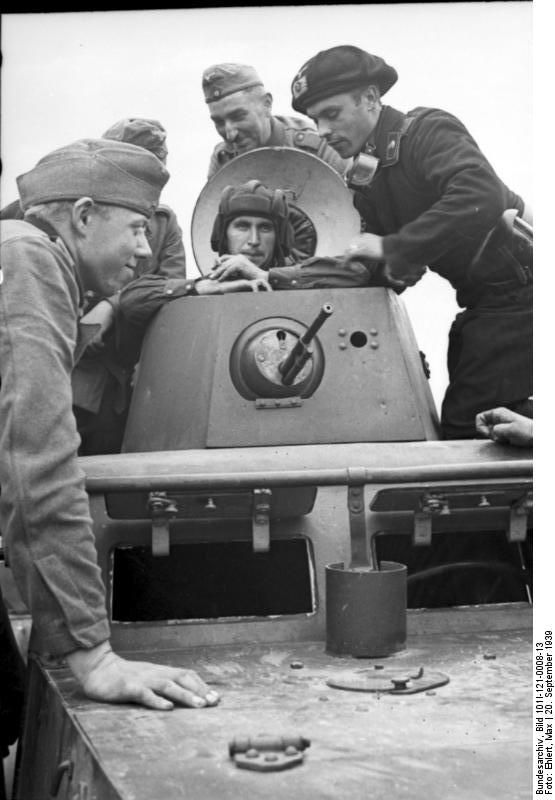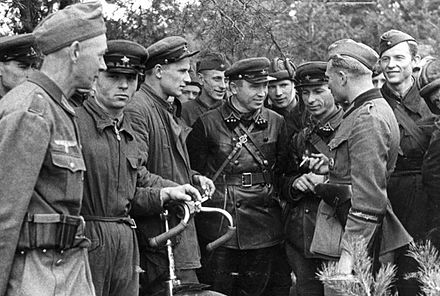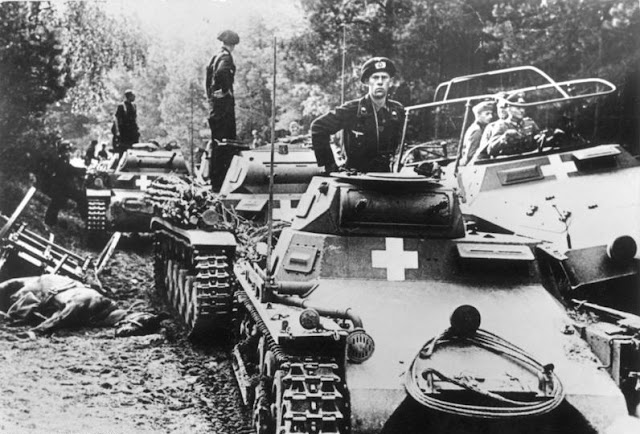Monday 24 November 1941
 |
| German troops on the outskirts of Leningrad, 24 November 1941 (AP). |
Eastern Front: German 1st Panzer Army expended tremendous effort and took many chances to capture Rostov-on-Don only a few days ago, but on
24 November 1941 the local commanders on the scene decide to evacuate it. The drive to Rostov required the Wehrmacht to open a long corridor to the city which is wide open to attack from the north. Soviet 9th and 37th Armies seize the opportunity and attempt to cut off the German spearhead in the city, but General Ewald von Kleist recognizes the danger and plans with Army Group South commander Field Marshal Gerd von Rundstedt to pull his troops out before he loses them. This withdrawal will require Adolf Hitler's permission, which he is unlikely to give - unless it is presented to him as a
fait accompli. Figuring out how to do this will require a lot of thought and planning.
 |
| "Men of the 4th Indian Division with a captured German flag at Sidi Omar, North Africa." © IWM (E 6940). |
Hitler wants Rostov held at all costs. The city is considered the "gateway to the Caucasus," and holding it would somewhat salvage the lofty goals for Operation Barbarossa in the spring. For the time being, III Corps in the city can hold out, but not for long. At OKH headquarters, General Franz Halder more-or-less agrees with the Fuhrer:
The situation north of Rostov is serious but not critical at the moment. At some points, the enemy is pressing against our new positions. The right wing of Seventeenth Army [just to the north of 1st Panzer Army] has to fight off serious attacks. The Italians are still doing nothing.
The danger is that the Soviets break through the Seventeenth Army front and then wheel down to the coast of Azov, cutting the 1st Panzer Army's only line of retreat. So far, that hasn't happened - but it still might. It will be the first time that the Wehrmacht has been forced to retreat from a major objective so the decision cannot be taken lightly.
 |
| HMS Dunedin, sunk by U-124 on 24 November 1941. |
Battle of the Atlantic: Kriegsmarine U-boat U-124 (Kptlt. Johann Mohr), on its seventh patrol out of Lorient, is operating roughly midway between Natal, Brazil and Monrovia, Liberia when it spots 4800-ton Royal Navy cruiser HMS Dunedin (Captain Richard Stratford Lovatt, RN). Dunedin has been searching the South Atlantic for German raider Atlantis as part of a three-cruiser task force. U-124 is on its way to refuel from supply ship Python but can't pass up the opportunity to attack. Dunedin's lookouts spot U-124's periscope but lose track of it again. After much maneuvering, Mohr pumps two out of three torpedoes into the cruiser's starboard side, causing it to sink quickly. There are about 250 men in the water, but Mohr only surfaces, circles the area, and then leaves without offering any aid. By the time U.S. freighter Nishmaha passes by three days later, only 72 men are left on six floats. Another five men perish from exposure on the way to the port at Trinidad. A total of four officers and 63 ratings survive to see land again.
 |
| "Blowing up British mines which had been in the water for months. The mines exploding just off the breakwater." Plymouth Sound off Cawsand Bay, 24 November 1941. © IWM (A 6370). |
Battle of the Mediterranean: The British Operation Crusader in North Africa that began on 21 November has turned into a wild melee with the outcome completely in doubt. British 7th Armored Division of Eighth Army has taken horrendous tank losses, and overall the British have lost about 350 tanks and had another 150 severely damaged. General Erwin Rommel has a couple of advantages over German generals everywhere else in the Wehrmacht:
- He has complete freedom of action and the Allies cannot predict his movements by decoding his radio transmissions;
- The Italian troops under his command are fighting hard and effectively.
Rommel has freedom of action because the Wehrmacht is focused on the Eastern Front and considers the North Africa Theater to be an unimportant sideshow. How he manages to get vital assistance from his Italian allies, though, is unclear.
 |
| Midway Atoll. "Aerial photograph, looking just south of west across the southern side of the atoll, 24 November 1941. Eastern Island, then the site of Midway's airfield, is in the foreground. Sand Island, the location of most other base facilities, is across the entrance channel. Official U.S. Navy Photograph, now in the collections of the U.S. National Archives." |
Today, after several brilliant attacks that have blunted the British offensive, Rommel counterattacks hard by sending elements of Afrika Corps and the Italian Ariete Division toward Sidi Omar. This is known as "The Dash to the Wire" because the panzers are heading toward the wire barrier at the border. The main goal of the attack is to relieve trapped German troops at Bardia and then destroy British lines of communication from Egypt. Rommel plans to broaden the attack on the 25th by adding the 15th Panzer Division. Operation Crusader thus has turned into two separate offensives going in opposite directions, one by the British to the west and the other by the Axis forces to the east. Both can't be successful, so a potentially decisive moment is brewing at the Egyptian/Libyan border.
 |
| "Indian troops move forward in lorries, supported by Matilda tanks, 24 November 1941." © IWM (E 3720E). |
Holocaust: The SS establishes a new camp at the fortress town of Terezin in occupied Czechoslovakia (called the Protectorate of Bohemia and Moravia since its formal incorporation into the Greater Reich). The camp, called Theresienstadt, is intended as a hybrid transit point and long-term Ghetto for Holocaust victims. It is euphemistically called a "retirement settlement" for Jewish elders and, at least at first, is a "show camp" for the Red Cross and others. The first trainload of residents, 342 young Jewish men, arrive today, the first of thousands, and make the 1.5-mile (2.4 km) walk from the train station. Conditions are brutal, the inmates are terribly mistreated, and people die as a matter of course even though technically Theresienstadt is not an extermination camp.
 |
| Admiral Thomas Hart, commander of the US Asiatic Fleet operating out of the Philippines, on the cover of Time magazine on 24 November 1941. |
November 1941November 1, 1941: Finns Attack Toward Murmansk RailwayNovember 2, 1941: Manstein Isolates SevastopolNovember 3, 1941: Japan Prepares to AttackNovember 4, 1941: German Advances in the SouthNovember 5, 1941: Last Peace Effort By JapanNovember 6, 1941: Stalin Casts Blame in an Unexpected DirectionNovember 7, 1941: Stalin's Big ParadeNovember 8, 1941: Germans Take TikhvinNovember 9, 1941: Duisburg Convoy DestructionNovember 10, 1941: Manstein Attacks SevastopolNovember 11, 1941: Finland's Double Game EruptsNovember 12, 1941: T-34 Tanks Take ChargeNovember 13, 1941: German Orsha ConferenceNovember 14, 1941: German Supply Network Breaking DownNovember 15, 1941: Operation Typhoon ResumesNovember 16, 1941: Manstein Captures KerchNovember 17, 1941: Finland Halts OperationsNovember 18, 1941: British Operation CrusaderNovember 19, 1941: Sydney vs. Kormoran DuelNovember 20, 1941: The US Rejects Final Japanese DemandNovember 21, 1941: Germans Take RostovNovember 22, 1941: Kleist in Trouble at RostovNovember 23, 1941: Germans Take Klin, Huge Battle in North AfricaNovember 24, 1941: Rommel CounterattacksNovember 25, 1941: HMS Barham SunkNovember 26, 1941: Japanese Fleet SailsNovember 27, 1941: British Relieve TobrukNovember 28, 1941: Rostov Evacuated, German Closest Approach to MoscowNovember 29, 1941: Hitler Furious About RetreatNovember 30, 1941: Japan Sets the Date for its Attack2020




















